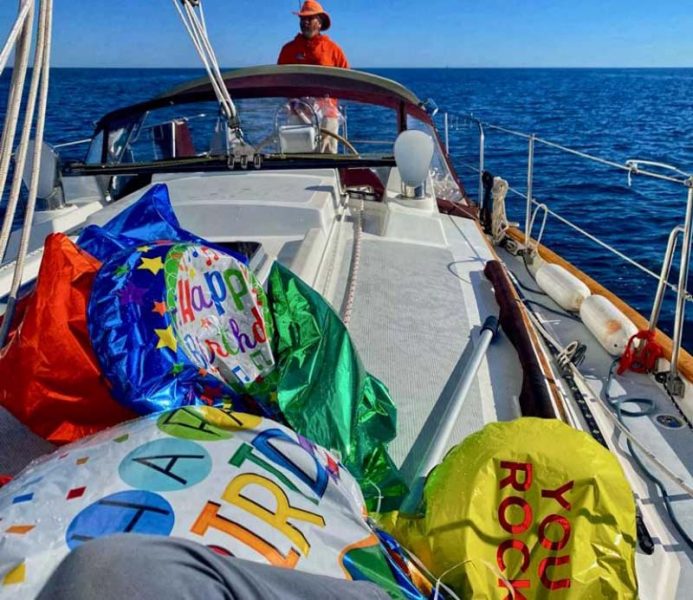
Sailors Are World Leaders for Sustainability on Earth Day and Every Day
Any sailor will tell you that one of the great reasons to sail is your connection to the sea and Mother Nature. Moving a boat across the Bay or around the world with just the power of the wind is an endlessly fascinating activity that heightens your awareness of and appreciation for the forces of nature. You also breathe in the fresh air, silently slip through the sea, and witness the ocean life that surrounds you. Every year on Earth Day, April 22, the world attempts to pause and recognize our planet that supports all life. Most sailors do this every day.
Focusing on the state of the world can be distressing, but sailors and sailing provide an example of a better way, the solutions we need, and relief from the threats we feel. On the micro-scale there are countless numbers of sailors who’ve learned how to live and enjoy life with a much lighter footprint on the planet. Is there a sailor anywhere who doesn’t marvel at and respect Lin and Larry Pardey’s circumnavigating the globe on their wooden, homebuilt, engineless, 24-ft Seraffyn? Similarly, we’re receiving lots of fan mail for Kenichi Horie, who’s more than halfway from San Francisco to Japan sailing aboard his engineless 19-ft aluminum cutter, Suntory Mermaid III. Sailors learn and know how to live simply.

Sailors are also pioneers in many of the leading technologies that will power our future. Sailors used wind to circle the globe long before PG&E learned how to send a utility bill. Our current issue features a story by Tim Henry on green repowering with electric and fuel-cell auxiliaries. The experimental Energy Observer, which passed through San Francisco in May 2021, has traveled to Japan for the Olympics and is now in Singapore with its innovative wing sails and solar- and wind- and hydro-powered hydrogen fuel cell technology.

It’s sailors like David Smyth who have repowered boats like his Olson 40, Euphoria, with an electric auxiliary while professionally working at Terraform Industries to solve the puzzle of carbon capture. A well-designed, well-sailed boat like the Olson 40 hardly needs auxiliary power at all while demonstrating that reducing the need for fossil fuel energy input is an ideal model for all Earth systems.

It only makes sense that someone living with just a few batteries and a small fuel tank would switch to solar power and LED lights long before a land-dweller who is plugged into a massive, carbon-spewing electrical grid where the impact from their energy usage is buried behind the grid and colorful green-marketing materials of central power utilities. Sailors constantly practice conservation and efficiency at sea and bring those lessons and habits ashore.
Bay Area sailor Bill Erkelens, who will sail in the Pacific Cup to Hawaii with his wife Melinda this summer on their Moore 24, Foamy, has a “day job” as chief operating officer for 11th Hour Racing Team’s entry in the upcoming The Ocean Race. They published a detailed and impressive report of their impacts and efforts toward more sustainable boatbuilding. This is notable for the tremendous commitment both The Ocean Race and 11th Hour Racing have made to sustainability, but we also like that Bill and Melinda continue to race in a minimalist, Santa Cruz-built Moore 24. Very cool.

Like The Ocean Race, SailGP came to town with an enormous footprint on the Bay and the local sailing scene and a big commitment to sustainability. To accomplish that, they created the SailGP Impact League to reward individual team sustainability efforts. It’s easy for people to talk smack about large-scale events that promise small-scale impacts on the planet. However, we recognize that the big events, which traditionally have had negative impacts, are making earnest efforts with truly transformational ideas. Humans and human activity are imperfect, but we see sailors everywhere working hard to make a difference.

Beyond the large-scale efforts, we recognize sailors like Carolyn Rosner and Mike Hay of the 1988 Passport 37 Sula sailing out of Ventura who, like many other sailors, will do what they can to clean up the oceans while they’re out enjoying a sail. There are so many other sailors who participate in beach cleanups, fuel up with biofuel, or turn the auxiliary off sooner or start it up later to save the burning of fossil fuels.

Sailors have learned to live with less and, not only that, they love it! Reducing the scale of their impact on the planet isn’t a burden, but is more eliminating the yoke on their neck of maintaining and supporting lots of “stuff.” Even more complicated sailboats are constantly looking for simplicity. The simplicity of sailing and cruising is freeing.
Many cruisers are now sailing with composting toilets (no holding tank, hoses, pumps or thru-hulls!). This is another sailor solution that could be brought ashore to save water in drought-prone California. In the Bay, the Wild Oyster Project is restoring the native, filter-feeding oyster that used to thrive here when Jack London sailed the Bay.

For sailors who travel long or short distances under just the power of the wind, with the sounds of nature close by and with their attention on the environment guiding their actions, the act of sailing is an alliance with the planet, not a battle against it. It’s finding alignment and agreement with something you care about and want to protect. For most sailors every day is Earth Day, and, because of this, we’re convinced if all the world were sailors, the world would be a better place. Enjoy the weekend of sailing ahead, and Happy Earth Day.
